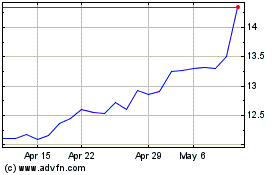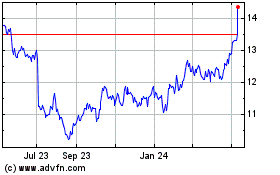China Speeds Up Bad-Loan Help for Banks
March 13 2016 - 8:50PM
Dow Jones News
BEIJING—Chinese regulators are speeding up ways to help banks
shed bad loans, but some of the measures risk keeping "zombie"
companies afloat while making lenders even more strapped for
capital.
The deepening economic slowdown has heightened the need for
banks to have more funds to lend out. A main feature in a plan
outlined by central-bank and regulatory officials over the weekend
would be to let banks sell dud loans to investors either by
repackaging them as securities or transferring them to special
asset-management companies that handle distressed debt.
Senior executives at China's Big Four state-owned banks say
regulators are also exploring ways for banks to exchange bad loans
for equity in certain too-big-to-fail companies—a potentially
controversial step that they say could saddle banks with
near-worthless stock and squeeze their liquidity.
Bank of China Ltd., one of the top four lenders, recently agreed
to become the largest shareholder in a publicly traded shipbuilder
under the yet-to-be-disclosed plan, people close to the bank say.
Officials at the central bank and banking regulatory agency
declined to comment.
The steps come as Chinese banks are seeing a surge in
nonperforming loans and a sharp decline in profitability, as they
absorb the effects of a yearslong lending binge. To make their
books look healthier, many banks have extended new credit to
corporate borrowers to repay existing debt.
Shang Fulin, chairman of the China Banking Regulatory
Commission, indicated at a news conference on Saturday that policy
makers see such rollover practices as a problem because the funds
aren't used to invest in new projects and create fresh demand.
"Through securitization and transfers of nonperforming assets, the
hope is to increase the turnover rate of bank lending, thereby
improving [banks'] ability to support the real economy," Mr. Shang
said.
Total soured loans in China's banking system reached 1.27
trillion yuan ($195.5 billion) as of December, the highest level
since mid-2006. Even as the official bad-loan ratio remains
relatively low, at 1.67% as of year-end, it has been steadily
climbing in the past three years. That is largely because Chinese
steelmakers, coal miners and other manufacturers find it
increasingly difficult to pay off debts because of weak demand and
excessive industrial capacity.
Nonperforming loans could peak at around 7% of all loans in
China in the current credit cycle, according to a recent analysis
by J.P. Morgan Chase & Co., meaning the entire banking sector
would need about $600 billion to replenish its capital. In a crisis
scenario, China's bad-loan ratio would hit 20% and the banking
system would require five trillion yuan ($770 billion) of capital,
according to the report.
"The key question is, what is the roadmap out of a credit cycle
or crisis?" asked the J.P. Morgan analysts.
Officials at the country's central bank, in particular, are wary
of risks associated with securitization of loans, pointing to how
risky securities tied to home mortgages helped trigger the 2008
global financial crisis. For now, the central bank has picked six
large Chinese banks for a trial run of securitizing tens of
billions of dollars of loans, according to people familiar with the
matter. The banks include the Big Four—Industrial & Commercial
Bank of China Ltd., China Construction Bank Corp., Agricultural
Bank of China Ltd. and Bank of China—along with Bank of
Communications Co. and China Merchants Bank.
Zhou Xiaochuan, China's central-bank governor, said Saturday
that such securities could attract investors who specialize in
buying troubled assets, but he stressed the need to draw lessons
from the global financial crisis in developing the market.
Regulators are also refining a practice pioneered by former
Premier Zhu Rongji, who in the late 1990s set up four state-owned
asset-management companies to take over large amounts of bad loans
from Chinese banks and resell them to other investors. Under the
new plan, the range would be expanded from the four to include
other institutional investors.
Meanwhile, as illustrated by the Bank of China example,
regulators are starting to open the door to more debt-for-equity
restructurings. Under the deal, the bank will hold about 14% of
equity in China Huarong Energy Co., listed in Hong Kong and based
in eastern China's Jiangsu province, in exchange for more than six
billion yuan of loans owed by the struggling shipbuilder.
Current banking rules generally forbid commercial banks from
taking stakes in nonfinancial entities. But regulators, led by the
powerful government commission overseeing state assets—known as the
State-owned Assets Supervision and Administration Commission, or
SASAC—are pushing for changes in the rules to help heavily indebted
state companies cut debts. Corporate debt now amounts to 160% of
China's gross domestic product, according to Standard & Poor's
Ratings Services. That is up from 98% in 2008 and compares with a
current U.S. level of 70%.
Blessed by the leadership's goal to help companies deleverage,
SASAC is compiling a list of big companies that could be slated for
debt-for-equity swaps, according to officials close to the
agency.
But many bankers think such swaps should only be allowed on a
limited scale. By exchanging loans for equity that would be worth
little if the companies already are struggling to pay off debts,
banks would be required to sharply bump up the amount of capital
they set aside against such equity holdings, which are considered
more risky than loans. That would strain their liquidity.
"It doesn't sound like a great idea to save zombie companies
with zombie banks," said Larry Hu, China economist at Macquarie
Securities, a Sydney-based investment bank.
Write to Lingling Wei at lingling.wei@wsj.com
(END) Dow Jones Newswires
March 13, 2016 20:35 ET (00:35 GMT)
Copyright (c) 2016 Dow Jones & Company, Inc.
China Construction Bank (PK) (USOTC:CICHY)
Historical Stock Chart
From Jun 2024 to Jul 2024

China Construction Bank (PK) (USOTC:CICHY)
Historical Stock Chart
From Jul 2023 to Jul 2024
